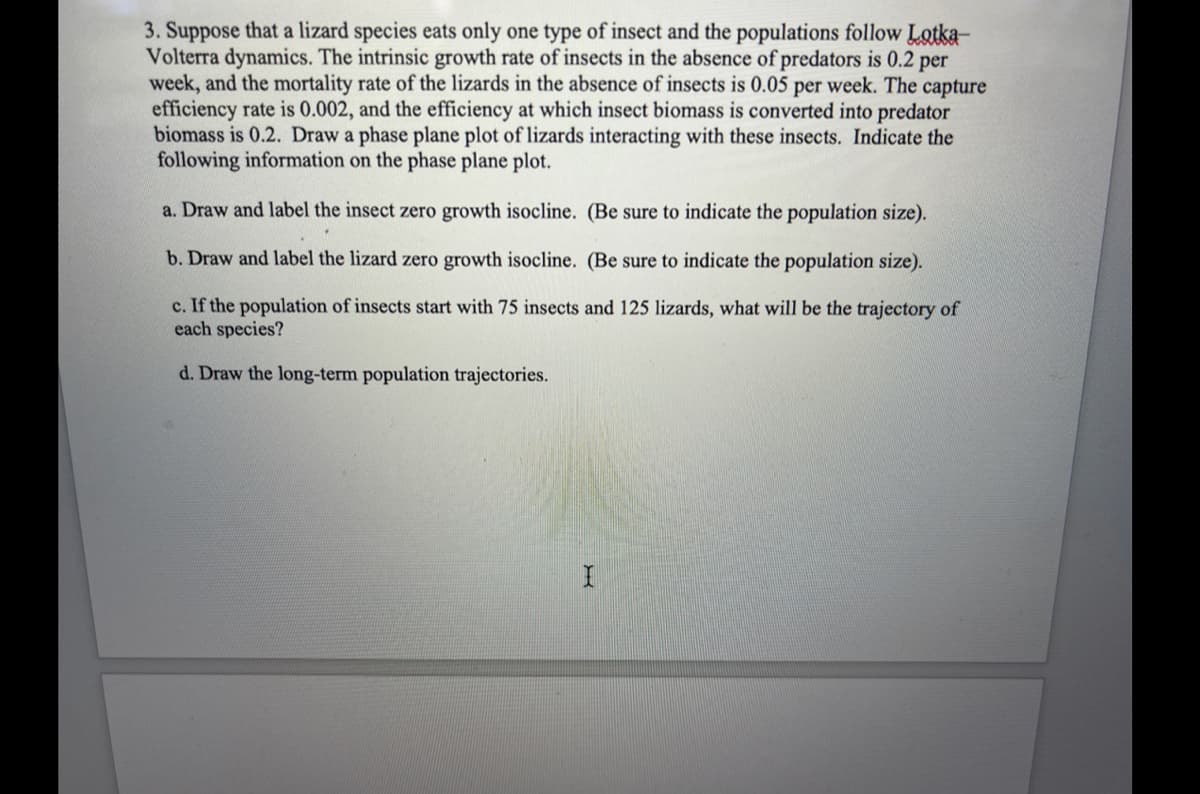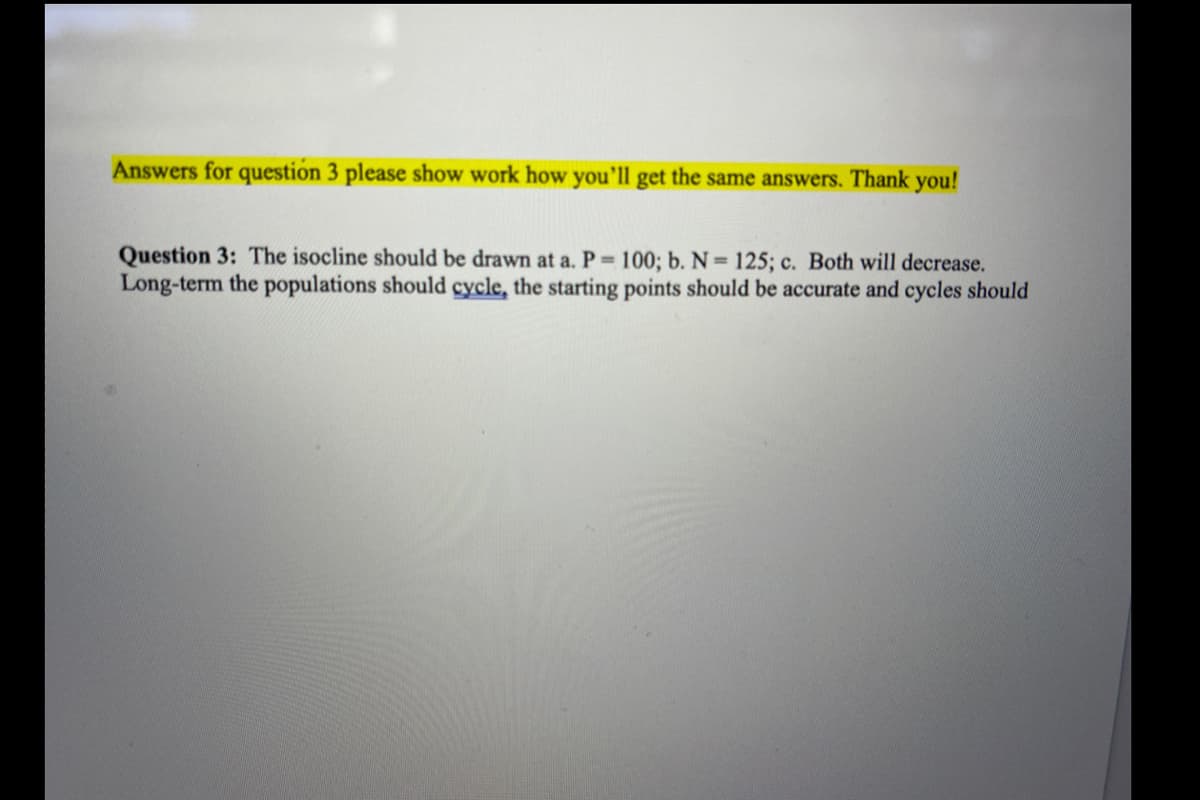3. Suppose that a lizard species eats only one type of insect and the populations follow Lotka- Volterra dynamics. The intrinsic growth rate of insects in the absence of predators is 0.2 per week, and the mortality rate of the lizards in the absence of insects is 0.05 per week. The capture efficiency rate is 0.002, and the efficiency at which insect biomass is converted into predator biomass is 0.2. Draw a phase plane plot of lizards interacting with these insects. Indicate the following information on the phase plane plot. a. Draw and label the insect zero growth isocline. (Be sure to indicate the population size). b. Draw and label the lizard zero growth isocline. (Be sure to indicate the population size). c. If the population of insects start with 75 insects and 125 lizards, what will be the trajectory of each species? d. Draw the long-term population trajectories.
3. Suppose that a lizard species eats only one type of insect and the populations follow Lotka- Volterra dynamics. The intrinsic growth rate of insects in the absence of predators is 0.2 per week, and the mortality rate of the lizards in the absence of insects is 0.05 per week. The capture efficiency rate is 0.002, and the efficiency at which insect biomass is converted into predator biomass is 0.2. Draw a phase plane plot of lizards interacting with these insects. Indicate the following information on the phase plane plot. a. Draw and label the insect zero growth isocline. (Be sure to indicate the population size). b. Draw and label the lizard zero growth isocline. (Be sure to indicate the population size). c. If the population of insects start with 75 insects and 125 lizards, what will be the trajectory of each species? d. Draw the long-term population trajectories.
Biology 2e
2nd Edition
ISBN:9781947172517
Author:Matthew Douglas, Jung Choi, Mary Ann Clark
Publisher:Matthew Douglas, Jung Choi, Mary Ann Clark
Chapter45: Population And Community Ecology
Section: Chapter Questions
Problem 2VCQ: Figure 45.10b If the major food source of the seals declines due to pollution or overfishing, which...
Related questions
Question

Transcribed Image Text:3. Suppose that a lizard species eats only one type of insect and the populations follow Lotka-
Volterra dynamics. The intrinsic growth rate of insects in the absence of predators is 0.2 per
week, and the mortality rate of the lizards in the absence of insects is 0.05 per week. The capture
efficiency rate is 0.002, and the efficiency at which insect biomass is converted into predator
biomass is 0.2. Draw a phase plane plot of lizards interacting with these insects. Indicate the
following information on the phase plane plot.
a. Draw and label the insect zero growth isocline. (Be sure to indicate the population size).
b. Draw and label the lizard zero growth isocline. (Be sure to indicate the population size).
c. If the population of insects start with 75 insects and 125 lizards, what will be the trajectory of
each species?
d. Draw the long-term population trajectories.

Transcribed Image Text:Answers for question 3 please show work how you'll get the same answers. Thank you!
Question 3: The isocline should be drawn at a. P= 100; b. N = 125; c. Both will decrease.
Long-term the populations should cycle, the starting points should be accurate and cycles should
Expert Solution
This question has been solved!
Explore an expertly crafted, step-by-step solution for a thorough understanding of key concepts.
This is a popular solution!
Trending now
This is a popular solution!
Step by step
Solved in 3 steps with 3 images

Knowledge Booster
Learn more about
Need a deep-dive on the concept behind this application? Look no further. Learn more about this topic, biology and related others by exploring similar questions and additional content below.Recommended textbooks for you

Biology 2e
Biology
ISBN:
9781947172517
Author:
Matthew Douglas, Jung Choi, Mary Ann Clark
Publisher:
OpenStax


Biology: The Dynamic Science (MindTap Course List)
Biology
ISBN:
9781305389892
Author:
Peter J. Russell, Paul E. Hertz, Beverly McMillan
Publisher:
Cengage Learning

Biology 2e
Biology
ISBN:
9781947172517
Author:
Matthew Douglas, Jung Choi, Mary Ann Clark
Publisher:
OpenStax


Biology: The Dynamic Science (MindTap Course List)
Biology
ISBN:
9781305389892
Author:
Peter J. Russell, Paul E. Hertz, Beverly McMillan
Publisher:
Cengage Learning

Biology: The Unity and Diversity of Life (MindTap…
Biology
ISBN:
9781305073951
Author:
Cecie Starr, Ralph Taggart, Christine Evers, Lisa Starr
Publisher:
Cengage Learning

Biology: The Unity and Diversity of Life (MindTap…
Biology
ISBN:
9781337408332
Author:
Cecie Starr, Ralph Taggart, Christine Evers, Lisa Starr
Publisher:
Cengage Learning